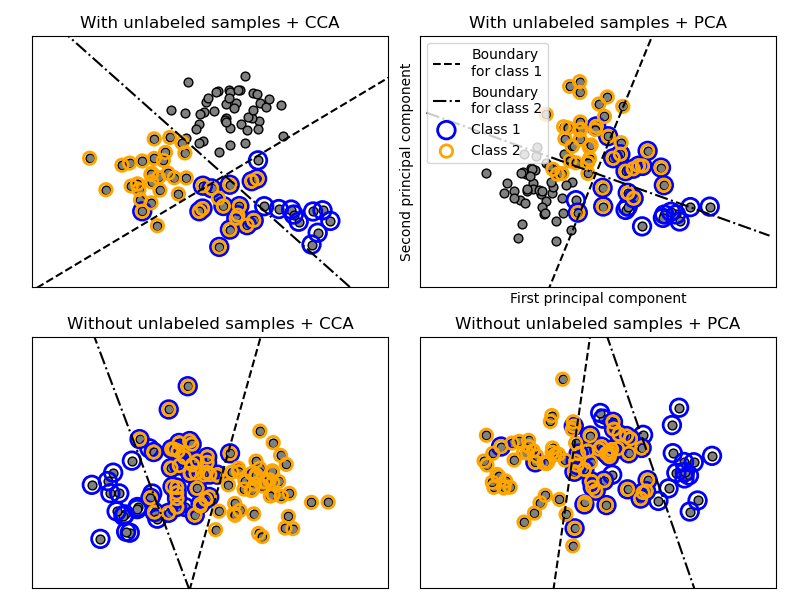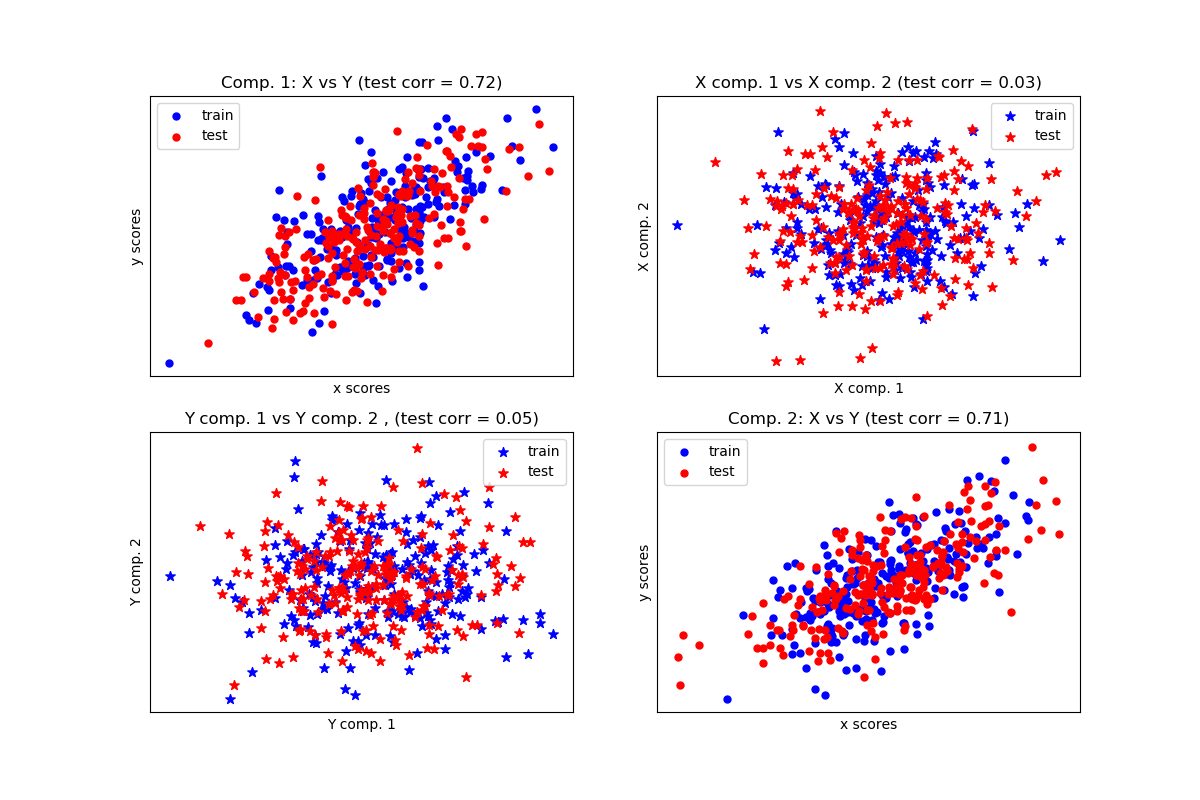sklearn.cross_decomposition.CCA?
class sklearn.cross_decomposition.CCA(n_components=2, *, scale=True, max_iter=500, tol=1e-06, copy=True)
CCA典型相關分析
CCA繼承mode=“B”和deflation_mode =“canonical”的PLS。
在用戶指南中閱讀更多內容。
| 參數 | 說明 |
|---|---|
| n_components | int, (default 2) 要保留的組件數。 |
| scale | boolean, (default True) 是否縮放數據? |
| max_iter | an integer, (default 500) NIPALS內部循環的最大迭代次數 |
| tol | non-negative real, default 1e-06. 迭代算法中使用的容差。 |
| copy | boolean 是否在副本上進行緊縮。 除非您不關心副作用,否則將默認值設為True |
| 屬性 | 說明 |
|---|---|
| x_weights_ | array, [p, n_components] X的權重向量。 |
| y_weights_ | array, [q, n_components] Y的權重向量。 |
| x_loadings_ | array, [p, n_components] X的加載向量。 |
| y_loadings_ | array, [q, n_components] Y的加載向量。 |
| x_scores_ | array, [n_samples, n_components] X的分數。 |
| y_scores_ | array, [n_samples, n_components] Y的分數。 |
| x_rotations_ | array, [p, n_components] X塊到隱藏的旋轉。 |
| y_rotations_ | array, [q, n_components] Y塊到隱藏的旋轉。 |
| coef_ | array of shape (p, q) 線性模型的系數:Y = X coef_ + Err |
| n_iter_ | array-like 每個組件的NIPALS內部循環的迭代次數。 |
另見:
注
對于每個分量k,找到使max corr(Xk u,Yk v)最大化的權重u,v,使得|u| = |v| = 1
注意,它僅使得分之間的相關性最大化。
X(Xk + 1)塊的殘差矩陣是通過收縮當前X分數x_score獲得的。
Y(Yk + 1)塊的殘差矩陣是通過收縮當前*Y分數獲得的。
參考
Jacob A. Wegelin. A survey of Partial Least Squares (PLS) methods, with emphasis on the two-block case. Technical Report 371, Department of Statistics, University of Washington, Seattle, 2000.
In french but still a reference: Tenenhaus, M. (1998). La regression PLS: theorie et pratique. Paris: Editions Technic.
示例
>>> from sklearn.cross_decomposition import CCA
>>> X = [[0., 0., 1.], [1.,0.,0.], [2.,2.,2.], [3.,5.,4.]]
>>> Y = [[0.1, -0.2], [0.9, 1.1], [6.2, 5.9], [11.9, 12.3]]
>>> cca = CCA(n_components=1)
>>> cca.fit(X, Y)
CCA(n_components=1)
>>> X_c, Y_c = cca.transform(X, Y)
方法
fit(self, X, Y) |
訓練數據 |
|---|---|
fit_transform(self, X[, y]) |
在訓練集上學習并應用降維。 |
get_params(self[, deep]) |
獲取評估器的參數。 |
inverse_transform(self, X) |
將數據轉換回其原始空間。 |
predict(self, X[, copy]) |
應用在訓練集學習到的降維。 |
score(self, X, y[, sample_weight]) |
返回預測的確定系數R^2。 |
set_params(self,**params) |
設置評估器參數。 |
transform(self, X[, Y, copy]) |
應用在訓練集上學習到的降維。 |
__init__(self, n_components=2, *, scale=True, max_iter=500, tol=1e-06, copy=True)
初始化self, 請參閱help(type(self))以獲得準確的說明
fit(self, X, Y)
訓練數據。
| 參數 | 說明 |
|---|---|
| X | array-like of shape (n_samples, n_features) 訓練向量,其中n_samples是樣本數,n_features是預測變量數。 |
| Y | array-like of shape (n_samples, n_targets) 目標向量,其中n_samples是樣本數,n_targets是響應變量數。 |
fit_transform(self, X, y=None)
在訓練集上學習并應用降維
| 參數 | 說明 |
|---|---|
| X | array-like of shape (n_samples, n_features) 訓練向量,其中n_samples是樣本數,n_features是預測變量數。 |
| y | array-like of shape (n_samples, n_targets) 目標向量,其中n_samples是樣本數,n_targets是響應變量數。 |
| 返回值 |
|---|
| 如果未指定Y,則為x_scores,否則為(x_scores,y_scores)。 |
get_params(self, deep=True)
獲取此估算器的參數。
| 參數 | 說明 |
|---|---|
| deep | bool, default=True 如果為True,將返回此估算器和其所包含子對象的參數。 |
| 返回值 | 說明 |
|---|---|
| params | mapping of string to any 參數名稱映射到其值。 |
inverse_transform(self, X)
將數據轉換回其原始空間。
| 參數 | 說明 |
|---|---|
| X | array-like of shape (n_samples, n_components) 新數據,其中n_samples是樣本數,n_components是pls分量數。 |
| 返回值 | 說明 |
|---|---|
| x_reconstructed | array-like of shape (n_samples, n_features) |
注
僅當n_components = n_features時,此轉換才是精確的
predict(self, X, copy=True)
在訓練集上學習到的降維應用
| 參數 | 說明 |
|---|---|
| X | array-like of shape (n_samples, n_features) 訓練向量,其中n_samples是樣本數,n_features是預測變量數。 |
| copy | boolean, default True 是復制X和Y,還是執行就地歸一化。 |
注
該調用需要估計p x q矩陣,這在高維空間中可能是個問題。
score(self, X, y, sample_weight=None)
返回預測的確定系數R^2。
系數R^2定義為(1- u/v),其中u是平方的殘差和((y_true-y_pred)** 2).sum(),而v是平方的總和((y_true- y_true.mean())** 2).sum()。 可能的最高得分為1.0,并且可能為負(因為該模型可能會更差)。 不管輸入特征如何,常數模型預測y的期望值,獲得的R^2分數將始終是0.0。
| 參數 | 說明 |
|---|---|
| X | array-like of shape (n_samples, n_features) 測試樣本。對于某些評估器,可以是預先計算的核矩陣或通用對象列表,shape =(n_samples,n_samples_fitted),其中n_samples_fitted是用于評估器訓練的樣本數。 |
| y | array-like of shape (n_samples,) or (n_samples, n_outputs) X的真實值。 |
| sample_weight | array-like of shape (n_samples,), default=None 樣本權重 |
| 返回值 | 說明 |
|---|---|
| score | float self.predict(X)關于y的R^2 |
注
在回歸器上調用score時使用的R2得分使用版本0.23中的multioutput ='uniform_average'來保持與r2_score的默認值一致。 這會影響所有多輸出回歸器的評分方法(MultiOutputRegressor除外)。
set_params(self, **params)
[源碼]
設置此估算器的參數。
該方法適用于簡單的估算器以及嵌套對象(例如管道)。后者具有形式參數<component>__<parameter>,以便可以更新嵌套對象的每個組件。
| 參數 | 說明 |
|---|---|
| **params | dict 估算器參數。 |
| 返回值 | 說明 |
|---|---|
| self | object 估算器實例。 |
transform(self, X, Y=None, copy=True)
[源碼]
在訓練集上學習到的降維應用
| 參數 | 說明 |
|---|---|
| X | array-like of shape (n_samples, n_features) 訓練向量,其中n_samples是樣本數,n_features是預測變量數。 |
| Y | array-like of shape (n_samples, n_targets) 目標向量,其中n_samples是樣本數,n_targets是響應變量數。 |
| copy | boolean, default True 是復制X和Y,還是執行就地歸一化。 |
| 返回值說明 |
|---|
| 如果未指定Y,則為x_scores,否則為(x_scores,y_scores)。 |


